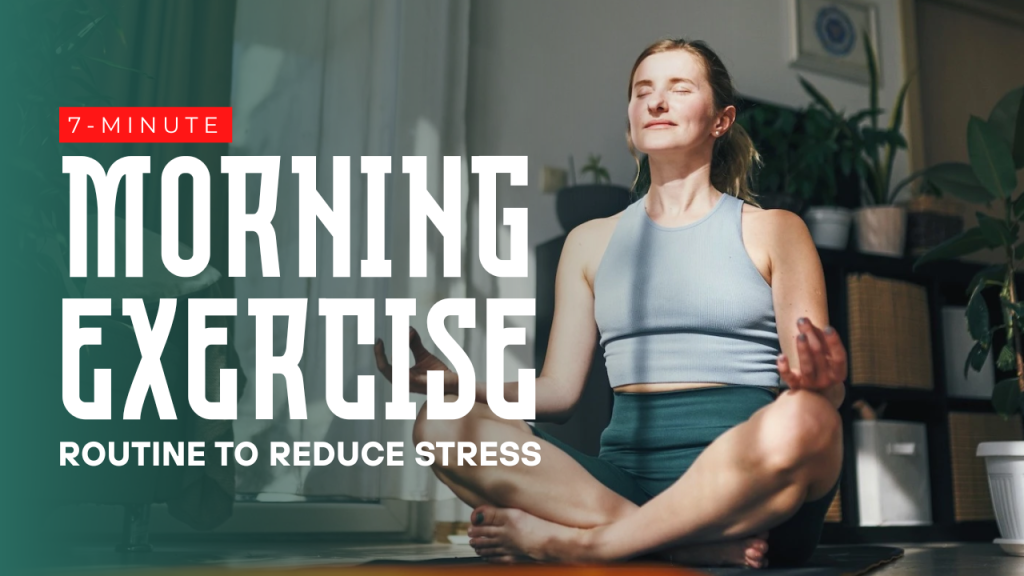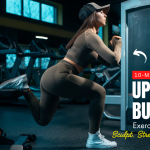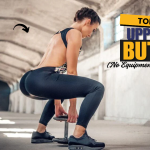Starting your day with a short, simple morning exercise routine can set the tone for a stress-free and energized morning. Physical movement helps release endorphins, lower cortisol levels, and improve mental clarity—all crucial for reducing stress and anxiety. This 7-minute routine is easy to do at home, requires no equipment, and is designed to calm your mind while energizing your body.

Table of Contents
Perks of This 7-Minute Morning Exercise Routine
1. Quick & Time-Efficient
- Only takes 7 minutes, making it easy to fit into even the busiest schedule.
- Provides a fast and effective way to boost energy and reduce stress.
2. No Equipment Required
- Can be done anywhere—home, office, or even while traveling.
- Saves money on gym memberships or workout gear.
3. Reduces Stress & Anxiety
- Focus on gentle movements and deep breathing to lower cortisol levels.
- Helps calm the mind, enhancing mental clarity and emotional stability.
4. Improves Flexibility & Posture
- Includes stretches that relieve muscle stiffness and improve mobility.
- Encourages better spinal alignment and posture awareness.
5. Enhances Blood Circulation
- Simple movements help increase blood flow, delivering more oxygen to the brain.
- It can prevent morning sluggishness and improve overall vitality.
6. Suitable for All Fitness Levels
- Beginner-friendly and adaptable for different ability levels.
- Gentle, low-impact movements that are easy on the joints.
7. Sets a Positive Tone for the Day
- Releases endorphins that improve mood and motivation.
- Establish a healthy morning habit for long-term well-being.
The 7-Minute Stress-Relief Workout Plan
Structure: 7 exercises, 45 seconds each, followed by a 15-second rest.
- Total Duration: 7 minutes
- Equipment: None
- Intensity: Low to moderate
- Rest: 15 seconds between exercises
1. Deep Breathing & Gentle Stretching (0:00 – 1:00)
- Duration: 1 minute
- How to do it:
- Stand tall or sit comfortably.
- Inhale deeply through your nose for 4 seconds.
- Hold for 4 seconds, then exhale slowly for 6 seconds.
- Simultaneously stretch your arms overhead and gently lean side to side.
- Benefits: Promotes relaxation, reduces tension, and prepares the body for movement.
2. Neck & Shoulder Rolls (1:00 – 2:00)
- Duration: 1 minute
- How to do it:
- Roll your shoulders forward and backward in slow, controlled circles.
- Tilt your head side to side, bringing your ear toward your shoulder.
- Slowly rotate your head in a circular motion.
- Benefits: Releases tension from the upper body, improves posture, and eases stiffness from sleep.
3. Cat-Cow Stretch (2:00 – 3:00)
- Duration: 1 minute
- How to do it:
- Get on all fours with wrists under shoulders and knees under hips.
- Inhale, arch your back, and lift your head and chest (Cow Pose).
- Exhale, round your back, and tuck your chin to your chest (Cat Pose).
- Repeat slowly.
- Benefits: Improves spinal flexibility, relieves back stiffness, and calms the mind.
4. Seated Forward Fold (3:00 – 4:00)
- Duration: 1 minute
- How to do it:
- Sit with legs extended straight.
- Inhale and lengthen your spine.
- Exhale and slowly fold forward, reaching for your toes or ankles.
- Hold the stretch while breathing deeply.
- Benefits: Relieves tension in the back and hamstrings, promotes relaxation, and enhances blood circulation.
5. Standing Side Stretches (4:00 – 5:00)
- Duration: 1 minute
- How to do it:
- Stand with feet hip-width apart.
- Raise your right arm overhead and lean left, stretching the right side.
- Hold for a few seconds, then switch sides.
- Repeat slowly.
- Benefits: Releases tension in the sides of the body, improves breathing capacity, and increases flexibility.
6. Gentle Marching in Place (5:00 – 6:00)
- Duration: 1 minute
- How to do it:
- Stand tall and march in place.
- Keep a steady pace, lifting your knees slightly.
- Swing your arms naturally.
- Benefits: Increases blood flow, wakes up the body, and prepares the mind for the day ahead.
7. Standing Forward Bend with Deep Breathing (6:00 – 7:00)
- Duration: 1 minute
- How to do it:
- Stand with feet hip-width apart.
- Inhale, then slowly bend forward at the hips, letting your arms dangle.
- Hold the position while taking slow, deep breaths.
- Gently roll up to standing position.
- Benefits: Relieves stress, calms the nervous system, and stretches the back and legs.
Final Thoughts
In just 7 minutes, this morning routine can help you release stress, improve circulation, and set a positive tone for the day. To maximize benefits:
- Perform it daily.
- Focus on deep breathing throughout.
- Adjust movements to your comfort level.
By incorporating this simple yet effective workout into your morning routine, you’ll experience a calmer mind, reduced anxiety, and a fresh start to your day. Try it out and feel the difference.
Frequently Asked Questions (FAQs)
Can I do this routine at any time of the day?
Yes, while it’s designed as a morning routine, you can perform it any time you need to reduce stress or relax.
Do I need any equipment?
No, this routine is completely equipment-free. Just use a comfortable space at home.
Can beginners follow this routine?
Absolutely! These exercises are beginner-friendly and can be modified as needed.
How often should I do this workout?
Daily practice is ideal for maximum benefits, but even a few times a week can help reduce stress and anxiety.
What if I don’t have 7 minutes?
You can shorten it by performing fewer exercises or reducing the duration of each move.
Can this routine help with sleep problems?
Yes, these exercises promote relaxation, which can contribute to better sleep quality when done consistently.
Should I consult a doctor before doing this routine?
If you have any pre-existing medical conditions, it’s always best to consult a healthcare professional before starting a new exercise regimen.





